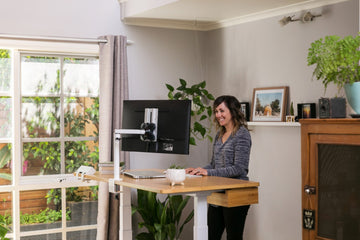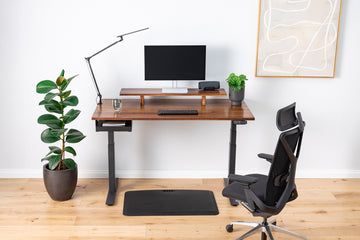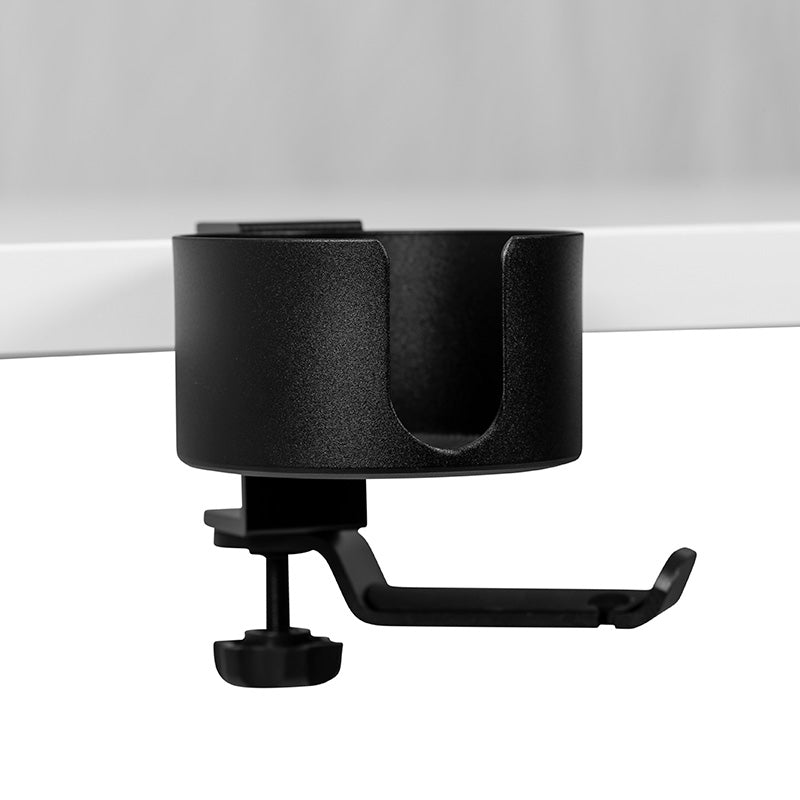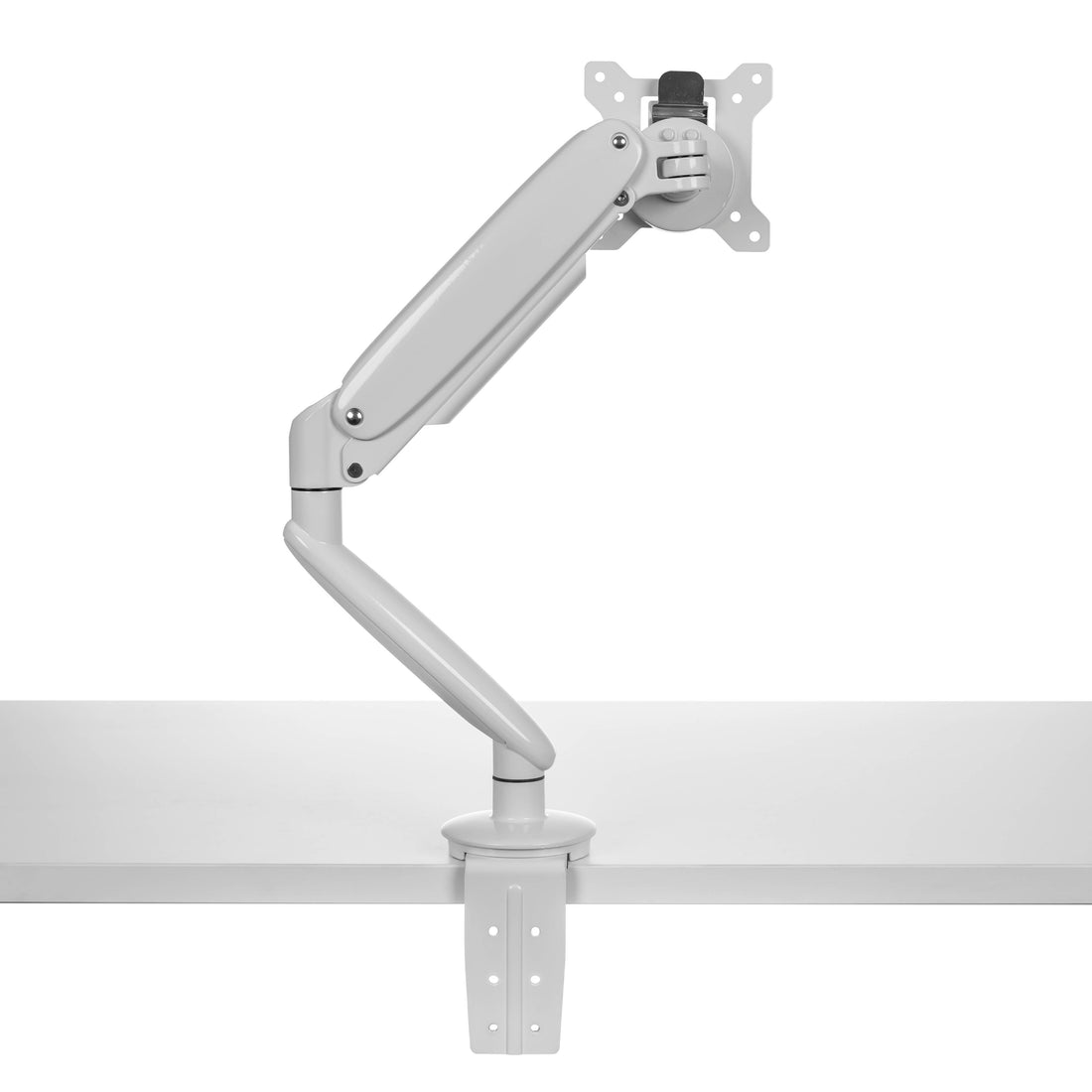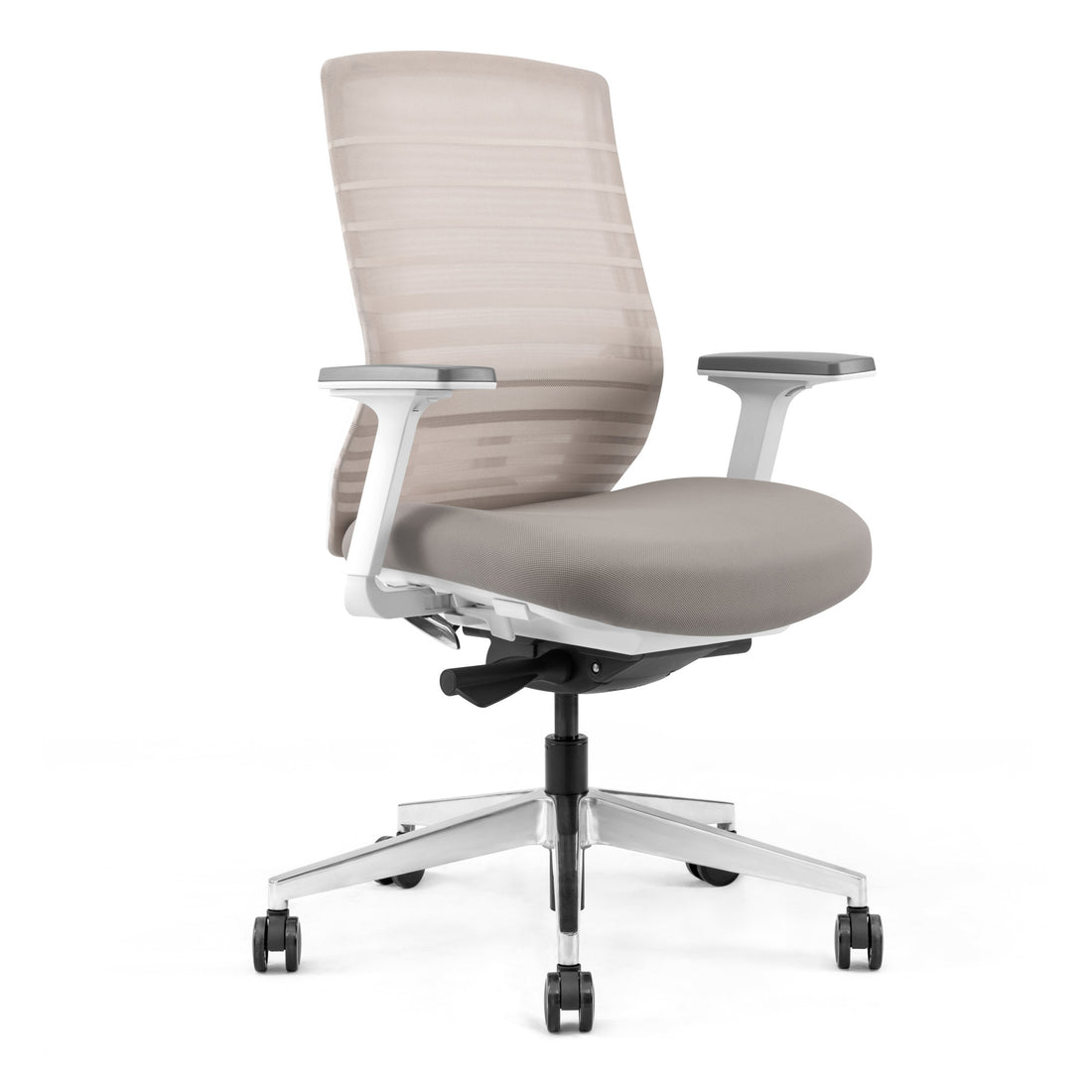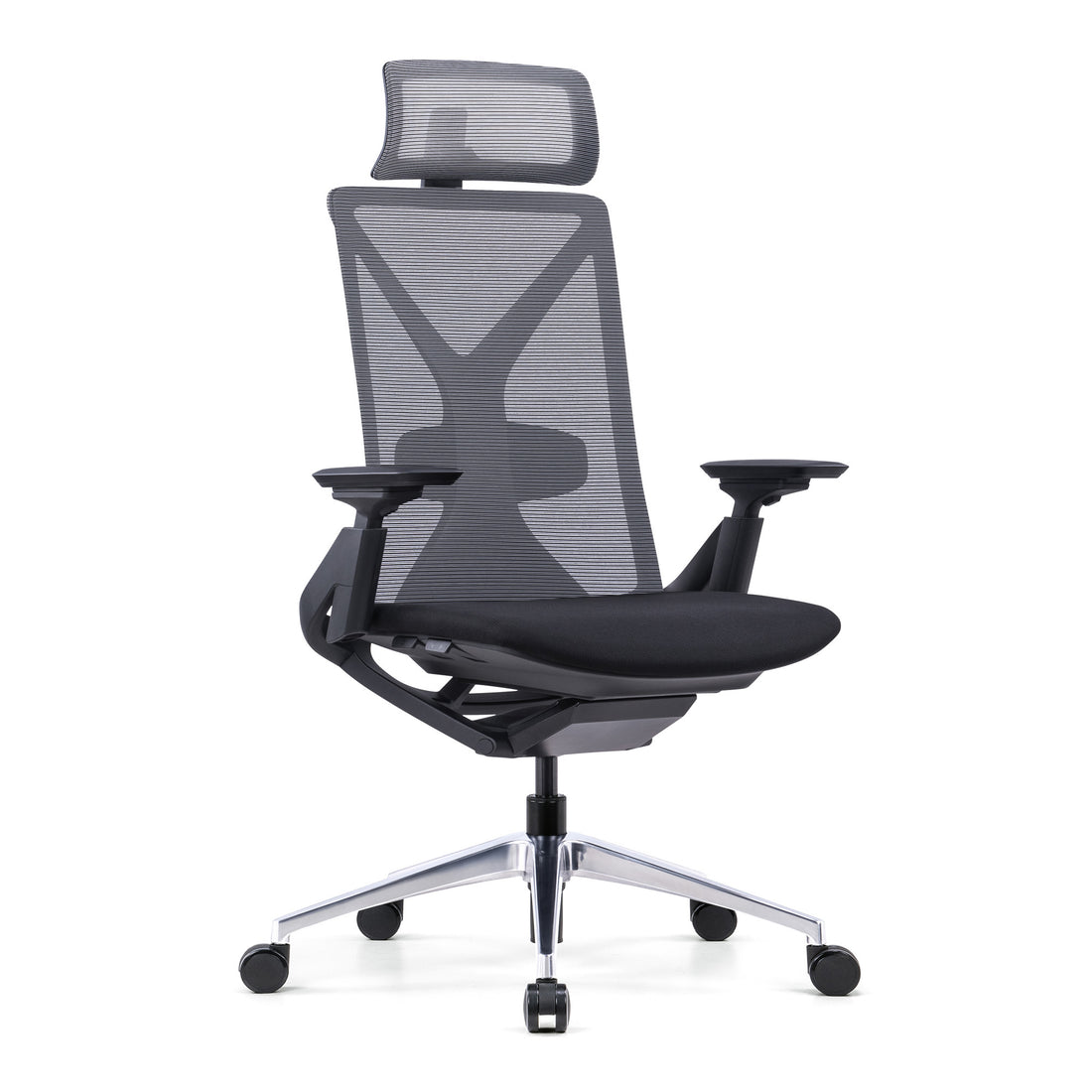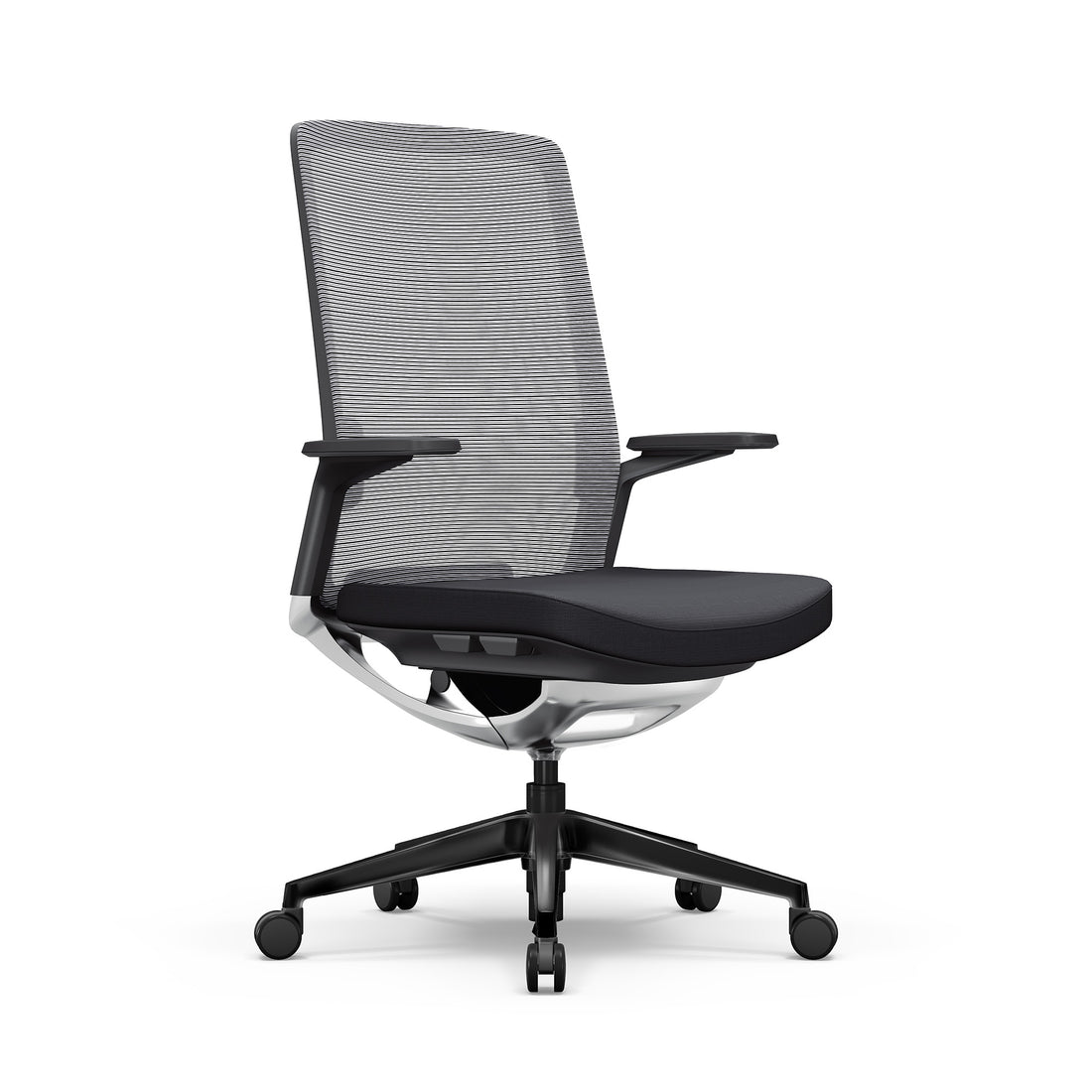Welcome to UpDown Desk's comprehensive guide on Standing Desk Exercises and Stretches. This blog provides a detailed workout guide designed to enhance the benefits of your sit-stand desk. Discover effective exercises and stretches tailored to address neck, back, and leg discomfort associated with prolonged desk work. Learn how to integrate these movements into your daily routine to reduce pain, boost productivity, and improve overall well-being.
Please note that while these exercises are general recommendations suitable for most people, individuals with existing injuries or specific health concerns should consult a healthcare professional before beginning any new exercise routine. Whether you're trying to ease discomfort or prevent future issues, this guide gives you practical tips to stay active and healthy at work—especially if you're using standing desks to boost your posture and keep you moving throughout the day.
The Importance of Movement and Desk Exercises
Why Movement is Essential for Desk Workers
Regular movement is crucial for maintaining circulation, muscle health, and joint flexibility. It helps prevent the stagnation that often leads to discomfort and long-term health problems. Without frequent movement, desk workers are more prone to issues like muscle stiffness, poor posture, and reduced mobility, which can affect both their health and productivity over time. Incorporating movement into a daily routine, such as small stretches or desk exercises, keeps the muscles engaged, the blood flowing, and the joints flexible. This consistent activity not only improves comfort throughout the day but also helps prevent the long-term health issues associated with prolonged sitting.
How Desk Exercises Can Improve Health and Productivity
Desk exercises go beyond just alleviating physical discomfort—they can significantly boost your mental clarity and productivity. When you engage in short bursts of physical activity throughout the day, such as standing desk exercises, you increase blood flow to the brain, which can help reduce stress levels and enhance focus. This, in turn, makes it easier to maintain high levels of productivity and creativity during work hours. Additionally, regular movement helps break the monotony of sitting or standing in one place, which can lead to fatigue and decreased motivation. Integrating these simple yet effective exercises into your routine, combined with the standing desk benefits of improved posture and reduced physical strain, can transform your workday into a more dynamic and productive experience.
Common Causes of Pain for Desk Workers
Neck and Shoulder Pain
Neck and shoulder pain is widespread among desk workers, primarily caused by poor posture, repetitive movements, and long periods of inactivity. The common habit of craning the neck forward to look at a screen puts excessive strain on the neck muscles, leading to tightness, discomfort, and even chronic pain over time. Hunching the shoulders or slouching can exacerbate this strain, causing further upper back and shoulder tension.
How Standing Desks Help
A well-adjusted standing desk can promote a more natural spine and neck alignment, reducing the forward head posture that often causes pain. By allowing you to position your monitor at eye level and your keyboard comfortably, a standing desk helps you maintain proper posture, thereby alleviating the stress on your neck and shoulders. This can significantly reduce discomfort and create a more pleasant working experience.
Lower Back Pain
Lower back pain is another common complaint among desk workers, frequently resulting from prolonged sitting or standing with poor posture. Sitting for extended periods can lead to muscle imbalances and tightness in the lower back while standing incorrectly can strain the lower back muscles. These issues are often compounded by a lack of movement, which can cause the muscles to weaken and lose flexibility, leading to chronic pain and discomfort.
How Standing Desks Help
Standing desks encourage you to change positions more frequently throughout the day, which helps alleviate the pressure on your lower back. By alternating between sitting and standing, you can prevent the stiffness and pain often resulting from remaining in one position for too long. Additionally, standing desks promote better posture by allowing you to engage your core muscles, which support the lower back and help maintain a neutral spine position. If you’re experiencing back pain, our standing desk and back pain guide offers further insights into how to manage and prevent it.
Hip and Leg Discomfort
Desk workers often experience hip and leg discomfort due to prolonged periods of sitting or standing without adequate movement. Sitting for long hours can cause the hip flexors to tighten and the glutes to weaken, leading to imbalances and discomfort in the hips and legs. Similarly, standing in one place for too long can lead to poor circulation and muscle fatigue, which may cause pain and stiffness in the legs.
How Standing Desks Help
Standing desks facilitate regular shifts between sitting and standing, improving blood circulation and reducing muscle stiffness in the hips and legs. This dynamic approach helps prevent the tightness and discomfort often accompanying prolonged sitting or standing. Additionally, standing desks encourage proper posture and ergonomic positioning, further alleviating discomfort in the lower body.

Essential Standing Desk Exercises
Incorporating standing desk exercises into your daily routine is key to staying active and preventing discomfort throughout the workday. Alongside general stretches, hip stretches at your desk play a vital role in maintaining flexibility and reducing stiffness in the lower body. Regularly performing these exercises can maintain flexibility, improve posture, and reduce the risk of developing pain or stiffness from prolonged desk work. It’s important to ensure your desk is set to the proper standing desk height to optimize these exercises and maintain correct posture throughout the day.
Neck and Shoulder Exercises
Your neck and shoulders are particularly vulnerable to tension and strain, especially if you spend long hours working at a desk. These exercises relieve stiffness and improve mobility in these critical areas, helping you maintain a more comfortable and pain-free posture.
Exercise 1: Neck Tilts
- How to Perform: Slowly tilt your head towards one shoulder, holding the stretch for a few seconds before returning to the starting position. Repeat on the other side.
- Benefits: Neck tilts are a simple yet effective way to stretch and relax the muscles along the sides of your neck. This exercise helps alleviate tension and prevent stiffness, often resulting from holding your head in one position for too long.
Exercise 2: Shoulder Shrugs
- How to Perform: Lift your shoulders towards your ears, hold them for a few seconds, then slowly lower them back to their natural position. Repeat the movement several times.
- Benefits: Shoulder shrugs help strengthen the upper back muscles while releasing shoulder tension. This exercise particularly benefits desk workers who tend to hunch their shoulders while working.
Exercise 3: Chin Tucks
- How to Perform: Tuck your chin towards your chest as if making a double chin, then return to the starting position. Focus on keeping your upper back straight, and your shoulders relaxed.
- Benefits: Chin tucks improve posture by strengthening the deep neck muscles, which helps reduce forward head posture. This exercise is excellent for counteracting the strain caused by looking down at a screen for extended periods.
Exercise 4: Arm Circles
- How to Perform: Extend your arms to the sides and make small circles with your hands, gradually increasing the size of the circles. After a set of circles in one direction, reverse the direction.
- Benefits: Arm circles warm up the shoulder joints and improve flexibility in the upper back. This exercise is a great way to relieve stiffness and get the blood flowing, especially after sitting or standing for long periods.
Lower Back Exercises
The lower back is another area prone to discomfort and pain, particularly if you sit or stand in one position for too long. These exercises strengthen the lower back muscles and improve flexibility, helping you maintain a healthier daily posture.
Exercise 1: Seated Torso Twists
- How to Perform: While seated, place your hands on your thighs and gently twist your torso to one side, holding the position for a few seconds before repeating on the other side.
- Benefits: Seated torso twists help stretch the muscles in the lower back and obliques, improving spinal mobility and relieving tension. This exercise is particularly useful for reducing stiffness and discomfort after sitting for an extended period.
Exercise 2: Standing Back Extensions
- How to Perform: Stand with your feet shoulder-width apart, place your hands on your lower back, and gently arch backward, holding the stretch for a few seconds before returning to the neutral position.
- Benefits: Standing back extensions strengthen the lower back muscles and counteract the effects of prolonged sitting, which can lead to a rounded spine. This exercise is ideal for improving posture and reducing lower back pain.
Exercise 3: Cat-Cow Stretch (Standing Variation)
- How to Perform: Stand with your feet hip-width apart, place your hands on your knees, and alternate between arching your back (cat position) and rounding it (cow position). Hold each position for a few seconds before moving to the next.
- Benefits: The cat-cow stretch increases flexibility in the spine and relieves tension in the lower back. This standing variation is perfect for desk workers who need a quick and effective way to stretch their back without leaving their workstations.
Exercise 4: Pelvic Tilts
- How to Perform: Stand with your feet hip-width apart and gently tilt your pelvis forward and backward, focusing on engaging your core muscles throughout the movement.
- Benefits: Pelvic tilts help improve lower back strength and flexibility while promoting a neutral spine position. This exercise is beneficial for maintaining proper posture and preventing lower back pain.
Hip and Leg Exercises
Your hips and legs bear the brunt of prolonged sitting or standing, making them particularly susceptible to stiffness and discomfort. The following exercises are designed to stretch and strengthen these areas, promoting better circulation and reducing the risk of pain.
Exercise 1: Hip Flexor Stretch
- How to Perform: Step one leg back into a lunge position, keeping your hips squared and your back straight. Hold the stretch for a few seconds before switching to the other leg.
- Benefits: The hip flexor stretch targets the muscles at the front of the hips, which often become tight from prolonged sitting. This stretch helps improve hip mobility and reduce lower back and leg discomfort.
Exercise 2: Calf Raises
- How to Perform: Stand with your feet shoulder-width apart, rise onto your toes, hold the position for a few seconds, and slowly lower your heels back to the floor.
- Benefits: Calf raises strengthen the lower legs and improve circulation, which can help prevent muscle fatigue and discomfort in the legs. This exercise is particularly useful for desk workers who stand for long periods.
Exercise 3: Seated Leg Extensions
- How to Perform: While seated, extend one leg straight, keeping your back and your core engaged. Hold the position for a few seconds before returning to the starting position.
- Benefits: Seated leg extensions strengthen the quadriceps and improve knee flexibility, making them an excellent exercise for preventing leg discomfort and enhancing overall lower body strength.
Exercise 4: Glute Bridges (Standing Variation)
- How to Perform: Stand with your feet hip-width apart, lift your heels off the ground while engaging your glutes, and hold the position for a few seconds before lowering your heels back down.
- Benefits: Glute bridges target the glutes and lower back muscles, helping to improve posture and prevent lower back pain. This standing variation is ideal for desk workers who want to engage their lower body muscles without lying down.
Full-Body Standing Desk Workout
- A full-body standing desk workout is a series of exercises performed while standing at your desk, designed to engage all major muscle groups throughout the workday. This type of workout targets multiple body areas, including the legs, core, arms, and shoulders, ensuring you stay active and improve overall strength, flexibility, and endurance. These movements can be done in short bursts without special equipment, making them an easy and effective way to stay fit during your work routine. Squats, calf raises, desk push-ups, and standing leg lifts can be performed in just a few minutes to keep your body engaged and energized.
Benefits of a Full-Body Workout
A full-body workout at your standing desk can provide a comprehensive approach to maintaining overall physical health. Engaging multiple muscle groups ensures your body stays balanced and strong, reducing the risk of injury and improving your posture. Full-body exercises can also enhance cardiovascular health, increase metabolism, and boost energy levels, making you more productive and focused throughout the day.
How to Incorporate Full-Body Movements
To effectively incorporate full-body movements into your workday, consider setting aside a few minutes every hour for a quick workout session. This could include upper-body exercises, lower-body stretches, and core-strengthening movements. By varying your exercises and focusing on different muscle groups, you can keep your routine engaging and ensure that all areas of your body receive adequate attention. Remember, the goal is to stay active and prevent the stiffness and discomfort often accompanying long desk hours.
Standing Desk Stretches for Pain Relief

Stretching is a key component of any desk routine, and integrating exercises at your desk can help relieve pain and prevent discomfort. These movements are designed to be quick and easy, allowing you to stretch while working without disrupting your tasks. For instance, standing desk stretches targeting the hips, back, and legs can help reduce the stiffness caused by sitting for extended periods.
Neck and Shoulder Stretches
The neck and shoulders are common areas of tension for desk workers. These stretches are designed to relieve stiffness and improve mobility in these critical areas, helping you maintain better posture and reduce the risk of pain.
Stretch 1: Neck Rotations
- How to Perform: Slowly rotate your neck in a circular motion, first in one direction, then the other. Keep the movement controlled and gentle to avoid straining the muscles.
- Benefits: Neck rotations increase flexibility and reduce tension, helping to prevent stiffness and discomfort that can develop after hours of sitting or standing.
Stretch 2: Shoulder Rolls
- How to Perform: Roll your shoulders forward and backward in a circular motion, focusing on smooth, controlled movements.
- Benefits: Shoulder rolls help release tension in the shoulders and upper back, improving posture and reducing the risk of developing shoulder pain.
Stretch 3: Upper Trapezius Stretch
- How to Perform: While sitting or standing, gently pull your head towards one shoulder, feeling the stretch along the opposite side of the neck. Hold for a few seconds, and then switch sides.
- Benefits: This stretch targets the upper trapezius muscles, often tight in desk workers due to poor posture and prolonged screen time. Regular stretching can help alleviate tension and improve neck mobility.
Stretch 4: Chest Opener Stretch
- How to Perform: Clasp your hands behind your back, straighten your arms, and gently lift them while opening up your chest. Hold the stretch for a few seconds and focus on breathing deeply.
- Benefits: The chest opener stretch improves flexibility in the chest and shoulders, counteracting the effects of slouching and helping to maintain good posture.
Lower Back Stretches
Stretching the lower back is essential for preventing pain and improving flexibility, especially if you sit or stand for long periods. These stretches target the lower back muscles, helping to reduce tension and promote a healthier spine.
Stretch 1: Cat-Cow Stretch
- How to Perform: Stand with your feet hip-width apart, place your hands on your knees, and alternate between arching your back (cat position) and rounding it (cow position). Hold each position for a few seconds before moving to the next.
- Benefits: The cat-cow stretch is excellent for increasing spinal flexibility and relieving tension in the lower back. This stretch helps maintain a healthy spine and can prevent lower back pain.
Stretch 2: Forward Bend
- How to Perform: Stand with your feet hip-width apart, bend forward at the waist, and reach towards your toes while keeping your knees slightly bent. Hold the stretch for a few seconds, feeling the stretch in your lower back and hamstrings.
- Benefits: Forward bends stretch the lower back and hamstrings, reducing stiffness and promoting flexibility. This stretch is particularly beneficial after sitting for long periods.
Stretch 3: Child’s Pose (Standing Variation)
- How to Perform: Stand with your feet hip-width apart, bend forward at the waist, and extend your arms in front of you, reaching towards the floor. Hold the stretch for a few seconds, focusing on relaxing your lower back and hips.
- Benefits: This standing variation of the child’s pose targets the lower back and hips, providing gentle relief from tension and promoting relaxation.
Stretch 4: Spinal Twist
- How to Perform: While seated or standing, gently twist your torso to one side, holding the position for a few seconds before switching to the other. Keep your hips facing forward and focus on rotating your spine.
- Benefits: Spinal twists improve mobility and relieve tension in the spine and lower back, helping to maintain a healthy and flexible spine.
Hip and Leg Stretches
Prolonged sitting or standing can easily stiffen the hips and legs. These stretches focus on improving flexibility and circulation in these areas, helping to reduce the risk of pain and stiffness.
Stretch 1: Seated Hamstring Stretch
- How to Perform: While seated, extend one leg before you, keeping your back straight and reaching towards your toes. Hold the stretch for a few seconds before switching to the other leg.
- Benefits: The seated hamstring stretch targets the hamstrings and lower back, improving flexibility and reducing the risk of injury. This stretch is particularly beneficial for desk workers who spend long hours sitting.
Stretch 2: Standing Quad Stretch
- How to Perform: Stand with your feet shoulder-width apart, bend one knee, pull your foot towards your buttocks, and hold onto a chair or desk for balance if needed. Hold the stretch for a few seconds before switching to the other leg.
- Benefits: The standing quad stretch targets the quadriceps and hip flexors, improving flexibility and reducing discomfort from prolonged sitting or standing.
Stretch 3: Figure Four Stretch
- How to Perform: Stand with your feet shoulder-width apart, cross one ankle over the opposite knee, and sit back into a squat position. Hold the stretch for a few seconds before switching to the other leg.
- Benefits: The figure four stretch targets the glutes and hips, helping to relieve tightness and improve flexibility. This stretch is particularly useful for preventing lower back and hip pain.
Stretch 4: Hip Flexor Stretch
- How to Perform: Step one leg back into a lunge position, keeping your hips squared and your back straight. Hold the stretch for a few seconds before switching to the other leg.
- Benefits: The hip flexor stretch targets the muscles at the front of the hips, which often become tight from prolonged sitting. This stretch helps improve hip mobility and reduce lower back and leg discomfort.
Complete Desk Exercise and Stretch Reference Table
We've compiled a comprehensive reference table to help you easily incorporate standing desk exercises, standing desk stretches, hip stretches at desk, and other exercises to do at your desk into your daily routine. This table provides clear guidance on the most effective movements you can perform at your desk, whether seated or standing. It details the target muscles, recommended frequency, and the ideal duration for each exercise or stretch, ensuring you can maximize the benefits with minimal disruption to your workday. Use this table as a quick reference to stay active, alleviate discomfort, and maintain a healthy standing desk posture throughout the day.
| Exercise/Stretch | Recommendation | Targeted Muscles | How Often | Reps/Sets | Duration | Notes |
| Neck Tilts | Tilt head towards each shoulder | Neck muscles | 2-3 times daily | 10-15 reps per side | 5-10 seconds per tilt | Keep shoulders relaxed |
| Shoulder Shrugs | Lift and lower shoulders | Shoulders, upper back | 2-3 times daily | 10-15 reps | 5-10 seconds per shrug | Perform slowly and with control |
| Chin Tucks | Tuck chin towards chest | Neck, upper back | 2-3 times daily | 10-15 reps | 5-10 seconds per tuck | Avoid rounding upper back |
| Arm Circles | Small circles with arms extended | Shoulders, upper back | 2-3 times daily | 10-15 reps per direction | 20-30 seconds per direction | Perform in both directions |
| Seated Torso Twists | Twist torso from side to side | Lower back, obliques | 1-2 times daily | 10-15 reps per side | 5-10 seconds per twist | Keep hips stable |
| Standing Back Extensions | Arch back slightly while standing | Lower back | 1-2 times daily | 10-15 reps | 5-10 seconds per extension | Avoid overextending |
| Cat-Cow Stretch (Standing) | Alternate arching and rounding back | Lower back, spine | 1-2 times daily | 10-15 reps | 5-10 seconds per movement | Perform in a controlled manner |
| Pelvic Tilts | Tilt pelvis forward and backward | Lower back, abs | 1-2 times daily | 10-15 reps | 5-10 seconds per tilt | Focus on engaging core muscles |
| Hip Flexor Stretch | Stretch one leg back while standing | Hip flexors, quads | 1-2 times daily | 15-30 seconds per side | 15-30 seconds per stretch | Keep hips squared |
| Calf Raises | Rise up on toes and lower slowly | Calves, lower legs | 2-3 times daily | 10-15 reps | 5-10 seconds per raise | Perform slowly for better results |
| Seated Leg Extensions | Extend one leg at a time | Quads | 1-2 times daily | 10-15 reps per leg | 5-10 seconds per extension | Keep back straight |
| Glute Bridges (Standing) | Lift heels off the ground while standing | Glutes, lower back | 1-2 times daily | 10-15 reps | 5-10 seconds per lift | Engage glutes throughout the movement |
| Neck Rotations | Rotate neck slowly in circles | Neck muscles | 1-2 times daily | 10-15 reps per direction | 5-10 seconds per rotation | Keep movements slow and controlled |
| Shoulder Rolls | Roll shoulders forward and backward | Shoulders, upper back | 1-2 times daily | 10-15 reps per direction | 20-30 seconds per direction | Perform in both directions |
| Upper Trapezius Stretch | Pull head gently towards shoulder | Upper trapezius, neck | 1-2 times daily | 15-30 seconds per side | 15-30 seconds per stretch | Avoid overstretching |
| Chest Opener Stretch | Clasp hands behind back and lift | Chest, shoulders | 1-2 times daily | 15-30 seconds per stretch | 15-30 seconds per stretch | Keep shoulders relaxed |
| Cat-Cow Stretch | Alternate arching and rounding back | Lower back, spine | 1-2 times daily | 10-15 reps | 5-10 seconds per movement | Perform in a controlled manner |
| Forward Bend | Bend forward at the waist | Lower back, hamstrings | 1-2 times daily | 15-30 seconds per stretch | 15-30 seconds per stretch | Keep knees slightly bent |
| Child’s Pose (Standing) | Bend forward with arms extended | Lower back, hips | 1-2 times daily | 15-30 seconds per stretch | 15-30 seconds per stretch | Maintain a gentle stretch |
| Spinal Twist | Twist torso while seated or standing | Spine, lower back | 1-2 times daily | 15-30 seconds per side | 15-30 seconds per twist | Keep hips facing forward |
| Seated Hamstring Stretch | Extend one leg out and reach towards toes | Hamstrings, lower back | 1-2 times daily | 15-30 seconds per leg | 15-30 seconds per stretch | Keep back straight |
| Standing Quad Stretch | Pull one foot towards buttocks while standing | Quads, hip flexors | 1-2 times daily | 15-30 seconds per leg | 15-30 seconds per stretch | Maintain balance while stretching |
| Figure Four Stretch | Cross one ankle over the opposite knee | Glutes, hips | 1-2 times daily | 15-30 seconds per leg | 15-30 seconds per stretch | Keep back straight |
| Hip Flexor Stretch | Lunge forward with one leg | Hip flexors, quads | 1-2 times daily | 15-30 seconds per leg | 15-30 seconds per stretch | Maintain an upright posture |
How to Choose the Right Exercises and Stretches
Identifying Your Goals: Pain Relief vs. Prevention
When selecting the right exercises and stretches, it's essential to start by identifying your primary goals. Are you seeking immediate pain relief due to discomfort, or are you more focused on preventing potential issues? Understanding your goals will guide you in creating a routine that addresses your specific needs, whether alleviating current pain or preventing future problems. Additionally, being aware of bad desk ergonomics is crucial in ensuring that your exercise routine effectively addresses and corrects any posture-related issues that might contribute to discomfort.
Exercises and Stretches for Immediate Pain Relief
For those seeking immediate relief, it’s crucial to focus on exercises and stretches that target the specific areas where you experience discomfort. For instance, incorporating lower back stretches and gentle movements can help ease tension and reduce pain if you suffer from pain. Similarly, neck and shoulder exercises should be prioritized to provide quick relief if your neck and shoulders are sore from hunching over a computer. These targeted activities can offer immediate benefits, helping to reduce pain and improve your comfort level during the workday.
Exercises and Stretches for Long-Term Prevention
A well-rounded routine that addresses all major muscle groups is essential if your goal is long-term prevention. This approach helps build strength and flexibility and reduces the risk of developing pain in the future. By regularly performing exercises and stretches that engage the neck, shoulders, back, hips, and legs, you can maintain overall muscle balance and joint health. This proactive approach will help you stay pain-free and enhance your physical resilience against the strains of prolonged desk work.
Tailoring Your Routine to Your Specific Needs
Each individual has unique needs based on their body, work habits, and existing conditions. Tailoring your exercise and stretch routine to these specific needs is key to achieving the best results. Whether you experience pain in certain areas or simply want to prevent potential issues, customizing your routine can ensure that you’re addressing the right muscle groups and working towards your personal goals.
Evaluating Your Current Pain Points
Begin by evaluating your current pain points. Do you frequently experience neck, shoulders, lower back, or leg discomfort? Identifying these areas will help you focus on your situation's most effective exercises and stretches. For example, if your hips often feel tight after a long day at the desk, incorporating hip stretches into your routine can relieve and prevent future stiffness.
Incorporating Exercises and Stretches Based on Your Work Habits
Consider how you spend your workday. If you stand for long periods, you should focus on exercises that relieve leg and hip discomfort. Conversely, if you sit frequently, you’ll want to emphasize back and shoulder exercises to counteract the effects of prolonged sitting. By aligning your routine with your work habits, you can optimize your exercise and stretch regimen to fit your lifestyle and needs.
Tips for Staying Consistent with Your Routine
Consistency is key to reaping the full benefits of your exercise and stretch routine. However, staying consistent can be challenging, especially in a busy work environment. Here are some practical tips to help you stay on track:
- Set Reminders: Use technology to your advantage by setting reminders on your phone or computer to take regular breaks for movement. These reminders can prompt you to stand up, stretch, or perform a quick exercise, helping you maintain consistency.
- Incorporate Movement into Your Workday: Explore opportunities to integrate movement into your daily tasks. For example, stand during phone calls, take short walking breaks, or stretch while waiting for a file to download. These small changes can add up to significant benefits over time.
- Start Small: If you’re new to incorporating exercises into your workday, start with just a few simple exercises and gradually add more as you become comfortable. This approach makes it easier to develop a sustainable routine you’re likely to stick with.
Essential Office Exercise Equipment to Enhance Your Routine
Benefits of Using Office Exercise Equipment
Incorporating office exercise equipment into your routine can significantly enhance the effectiveness of your standing desk workouts. These tools are designed to integrate seamlessly into your workspace, allowing you to stay active without disrupting your workflow. Whether you want to increase your daily movement, strengthen specific muscle groups, or improve your overall fitness, the right equipment, such as standing desk accessories and ergonomic office chairs, can make your exercise routine more effective and enjoyable. Ergonomic office chairs, in particular, are essential for maintaining proper posture and reducing strain during extended periods of sitting, making them an excellent complement to your exercise efforts.
Top Equipment Recommendations
Here are some top equipment recommendations that can enhance your office exercise routine:
Under-Desk Elliptical
- Benefits: An under-desk elliptical provides a low-impact cardio workout you can perform while sitting or standing. This equipment is ideal for keeping your legs active, improving circulation, and burning calories without leaving your desk.
- How to Use: Place the elliptical under your desk and pedal during work tasks. It’s a convenient way to stay active throughout the day, especially during extended sitting periods.
Balance Ball Chair
- Benefits: A balance ball chair engages your core muscles while you sit, improving posture and stability. This equipment is particularly beneficial for those who spend long hours sitting, as it encourages active sitting and reduces the risk of developing back pain.
- How to Use: Most of the day, replace your regular office chair with a balance ball chair. This simple switch can help strengthen your core muscles and improve your posture.
Resistance Bands
- Benefits: Resistance bands are versatile and portable, making them an excellent addition to your office workout routine. They can be used for various strength exercises, targeting different muscle groups without needing heavy weights. Integrating resistance bands into your standing desk exercises can help add intensity and variety to your routine.
- How to Use: Incorporate resistance bands into your stretching and strength routines to add extra resistance and intensity. They’re perfect for exercises that target the upper body, lower body, and core and can be paired with hip stretches at desk for comprehensive muscle engagement.
Foam Rollers
- Benefits: Foam rollers are effective for releasing muscle tension and improving flexibility. They can also massage tight muscles and improve circulation, making them valuable to your post-workout routine.
- How to Use: Use a foam roller to target tight or sore muscles, especially after a long day of sitting or standing. Rolling out your muscles can help reduce soreness and enhance recovery.
Conclusion: Maximizing Your Sit-Stand Desk Benefits
Recap of Key Points
Incorporating standing desk exercises, stretches, and simple exercises to do at your desk into your daily routine can significantly boost your health, well-being, and productivity. By addressing common pain points, such as neck, shoulder, lower back, hip, and leg discomfort, and tailoring your exercise and stretch routine to your specific needs, you can maximize the benefits of your sit-stand desk. Additionally, using the right office exercise equipment can enhance your routine, making staying active and healthy throughout the workday easier.
Encouragement to Stay Active and Healthy at Work
Staying active throughout the workday doesn’t have to be complicated or time-consuming. Integrating these exercises, stretches, and equipment into your routine can create a healthier, more dynamic work environment. Remember, the key to long-term success is consistency—so commit to moving regularly, stretch often, and take advantage of the benefits your sit-stand desk has to offer. Your body and mind will thank you for it!
FAQ
Can You Exercise at a Standing Desk?
Yes, you can exercise at a standing desk. Simple movements like calf raises, leg lifts, and stretches can easily be done without leaving your workspace. Incorporating these exercises into your day can improve circulation, reduce stiffness, and keep your muscles engaged.
What Is the Core Exercise at a Standing Desk?
A highly effective core exercise at a standing desk is the pelvic tilt. Tilting your pelvis forward and backward while engaging your core muscles strengthens the lower back and abdominal muscles, promoting better posture and stability.
Is Standing at a Desk Good for Abs?
Standing at a desk can be good for your abs if you engage them actively. Maintaining an upright posture while standing requires core engagement, which can help strengthen your abdominal muscles over time. Adding core-focused exercises, such as standing side crunches or leg lifts, can enhance the benefits.
Do Standing Desks Build Muscle?
Standing desks can help build muscle, particularly in the legs, core, and lower back. By promoting movement and encouraging stabilizing muscles, standing desks can contribute to muscle endurance and strength. However, for significant muscle building, it’s essential to incorporate specific strength-training exercises.
How Do You Stretch Your Hips at a Standing Desk?
Perform a hip flexor stretch to stretch your hips at a standing desk. Step one leg back into a lunge position, keeping your hips squared, and gently press your hips forward. Hold the stretch on each side for 15-30 seconds to relieve tightness and improve flexibility.
How Do You Stretch Your Lower Back at a Standing Desk?
The cat-cow stretch (standing variation) effectively stretches your lower back at a standing desk. Place your hands on your knees, arch your back (cat position), and round it (cow position). This movement increases spinal flexibility and alleviates lower back tension.
How to Build Stamina for a Standing Desk?
Gradually increase your time standing daily to build stamina for a standing desk. Start with short intervals and slowly extend the duration. Incorporate regular movement, such as light stretches and shifts in posture, to reduce fatigue and build endurance over time.
How to Not Get Tired at a Standing Desk?
To avoid getting tired at a standing desk, shift your weight regularly and take short breaks to sit or move around. Wearing supportive footwear, using an anti-fatigue mat, and maintaining proper posture can also help reduce fatigue and keep you comfortable throughout the day.

